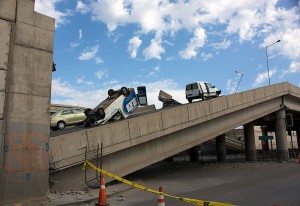‘Bad Year For Natural Hazard Exposure’
 Despite an unusually mild 2010 Atlantic hurricane season last year was among the five costliest years for the insurance industry since 1980 — and Bermuda re/insurers are among the global industry players reappraising their exposure to natural hazards, a leading trade publication said yesterday [Feb.25].
Despite an unusually mild 2010 Atlantic hurricane season last year was among the five costliest years for the insurance industry since 1980 — and Bermuda re/insurers are among the global industry players reappraising their exposure to natural hazards, a leading trade publication said yesterday [Feb.25].
“Insurance & Technology” reports with the highest winter storm losses in almost a decade among other calamities, the US set a record for overall number of natural catastrophes, with 247; and the global figure of 950 events was the second highest since 1980.
The Chilean earthquake [pictured] was the second costliest earthquake for the insurance industry since 1950. And the September temblor which struck Christchurch, New Zealand was the costliest natural disaster ever to strike the Australia/Oceania region prior to this week’s catastrophic aftershock. And severe flooding in Queensland, Australia began in December and became worse following the January 1 policy renewal date.
In the face of increasing events of certain types, reinsurers are reevaluating their books of business, said to Mr. DeMartini. Reacting to the severe thunderstorm, tornadoes and hailstorm activity in the Midwest over the last three years, reinsurers are increasing pricing and adjusting the capacity they allocate to the region.
“We’re aware of a major Bermuda-based reinsurer trimming its Midwest book by a third,” Mr. DeMartini said. “The industry has arrived at a kind of ‘enough is enough’ situation.”
The costly events of 2010 are likely to force industry to reevaluate existing catastrophe models, a spokesman for Deloitte’s national insurance group told the journal. Existing models probably underestimated the probability and loss profile of events such as European wind and cold weather storms.
“In a year such as 2010, events such as these can add up for insurers who have significant global exposure,” said the spokesman.
However, models don’t merely need to reflect a better understanding of newer high-loss natural catastrophes. Risk modelling companies have begun to predict higher probable losses for Atlantic hurricanes as well. Later this month, Risk Management Solutions [RMS] will release a controversial new model that factors in the experience of hurricanes which caused significant inland damage. The RMS model is the unofficial industry standard among Bermuda reinsurance companies.
“RMS has determined that there are other areas in Texas, the Mid-Atlantic and the Northeast that will be impacted in similar fashion by future hurricanes,” he says.
Once the new model is run against insurers’ portfolios, it is likely to increase reinsurance pricing, Mr. DeMartini suggested.

